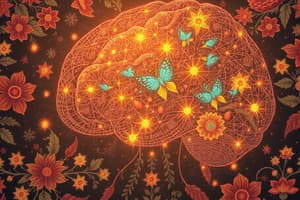Podcast
Questions and Answers
What are the five primary senses?
What are the five primary senses?
- Sight, sound, touch, taste, and smell (correct)
- Sight, sound, touch, taste, and proprioception
- Sight, sound, touch, taste, and balance
- Sight, sound, touch, temperature, and smell
What is the sense of agency?
What is the sense of agency?
- The ability to perceive body balance
- The ability to perceive time intervals
- The subjective feeling of having chosen a particular action (correct)
- The ability to recognize faces
What is the preattentive stage of perception?
What is the preattentive stage of perception?
- A stage that involves interpreting ambiguous figures so that they see what they want to see
- A stage that involves recognizing the same object from widely varying sensory inputs
- A conscious stage that involves merging characteristics of a stimulus to form one percept
- A largely unconscious stage that analyzes an object by breaking it down into its basic features (correct)
What are the principles of grouping?
What are the principles of grouping?
What is the effect of motivation and expectation on perception?
What is the effect of motivation and expectation on perception?
What is the FIT theory?
What is the FIT theory?
What is chronoception?
What is chronoception?
What is embodied cognition?
What is embodied cognition?
What is the effect of experience on perception?
What is the effect of experience on perception?
Flashcards
Perception
Perception
The organization, identification, and interpretation of sensory information.
Speech Perception
Speech Perception
The process by which spoken language is heard, interpreted, and understood.
Facial Perception
Facial Perception
Cognitive processes specialized in handling human faces and facial expressions.
Multi-modal Perception
Multi-modal Perception
Signup and view all the flashcards
Sense of Agency
Sense of Agency
Signup and view all the flashcards
Perceptual Constancy
Perceptual Constancy
Signup and view all the flashcards
Gestalt Laws of Grouping
Gestalt Laws of Grouping
Signup and view all the flashcards
Closed-loop Perception
Closed-loop Perception
Signup and view all the flashcards
Perceptual Set
Perceptual Set
Signup and view all the flashcards
Study Notes
Interpretation of Sensory Information:
-
Perception involves the organization, identification, and interpretation of sensory information to represent and understand the environment.
-
Sensory input is transformed from low-level to higher-level information by a process that connects a person's concepts and expectations.
-
Perception is shaped by learning, memory, expectation, and attention, and is an active process of hypothesis testing.
-
The brain's perceptual systems actively and pre-consciously attempt to make sense of input, as demonstrated by the study of illusions and ambiguous images.
-
Vision, hearing, touch, taste, and smell are the five primary senses, each with its own sensory organs and neural pathways.
-
The perceptual systems of the brain enable individuals to see the world as stable, even though sensory information is incomplete and rapidly varying.
-
Social perception is the part of perception that allows people to understand individuals and groups of their social world.
-
Speech perception is the process by which spoken language is heard, interpreted, and understood.
-
Facial perception refers to cognitive processes specialized in handling human faces and facial expressions.
-
Affective touch is a type of sensory information that elicits an emotional reaction and is usually social in nature.
-
Multi-modal perception refers to concurrent stimulation in more than one sensory modality and the effect it has on the perception of events and objects in the world.
-
Chronoception refers to how the passage of time is perceived and experienced.Overview of Perception
-
Perception is the process by which the brain interprets sensory information and creates subjective experiences of the world.
-
Perception is a distributed system involving the cerebral cortex, cerebellum, and basal ganglia, with different components responsible for different aspects of perception, such as the circadian rhythm and interval timing.
-
Sense of agency refers to the subjective feeling of having chosen a particular action, and can be affected by conditions such as schizophrenia. There is a measurable difference between the making of a decision and the feeling of agency.
-
Recognition memory is sometimes divided into two functions by neuroscientists: familiarity and recollection. The perirhinal cortex is connected with the sense of familiarity in humans and other mammals.
-
Sexual stimulation is any stimulus that leads to, enhances, and maintains sexual arousal, possibly even leading to orgasm.
-
Other senses enable perception of body balance, acceleration, gravity, position of body parts, temperature, and pain.
-
Perceptual constancy is the ability of perceptual systems to recognize the same object from widely varying sensory inputs, including color, roughness, melody, odor, brightness, and words.
-
The principles of grouping (or Gestalt laws of grouping) are a set of principles in psychology to explain how humans naturally perceive objects as organized patterns and objects.
-
The perceived qualities of an object can be affected by the qualities of context, known as contrast effects.
-
Cognitive theories of perception assume there is a poverty of stimulus, while the perceptual ecology approach was introduced by James J. Gibson, who rejected this assumption and argued that perception is direct and information-based.
-
Evolutionary psychologists hold that the primary purpose of perception is to guide action, and that sense organs evolve only when they provide exceptional benefits to an organism's fitness. Sensory abilities of different organisms often co-evolve.Theories and Effects of Perception
-
Face-reading module: some people cannot recognize faces, suggesting a specialized module for face recognition.
-
Closed-loop perception: proposes a dynamic motor-sensory closed-loop process in which information flows through the environment and the brain in continuous loops.
-
Feature integration theory (FIT): explains how characteristics of a stimulus, such as location in space, motion, color, and shape, are merged to form one percept through a two-part system of perception involving the preattentive and focused attention stages.
-
Preattentive stage of perception: largely unconscious, analyzes an object by breaking it down into its basic features. Unconnected features described in this stage are combined into the objects one normally sees during the focused attention stage.
-
Effects of experience: organisms can learn to make finer perceptual distinctions and learn new kinds of categorization. Specific practices like yoga and mindfulness can modify human perceptual modality and enable perception skills to switch from the external to a higher ability to focus on internal signals.
-
Effect of motivation and expectation: a perceptual set is a predisposition to perceive things in a certain way. Perception can be shaped by "top-down" processes such as drives and expectations. Perceptual sets can be created by motivation and can result in people interpreting ambiguous figures so that they see what they want to see.
-
Embodied cognition: challenges the idea of perception as internal representations resulting from a passive reception of (incomplete) sensory inputs coming from the outside world.
-
Predictive coding: starts with very broad constraints and expectations for the state of the world, and as expectations are met, it makes more detailed predictions. Perceptual experiences often shape our beliefs, but those perceptions were based on existing beliefs.
-
Feedback between perception and expectation: assists in stabilizing our inference-making process about the physical world, such as with perceptual constancy examples.
Studying That Suits You
Use AI to generate personalized quizzes and flashcards to suit your learning preferences.




